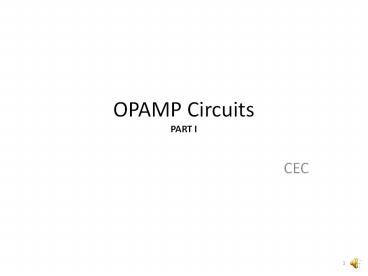Summing and Difference Amplifiers PowerPoint PPT Presentation
Title: Summing and Difference Amplifiers
1
OPAMP CircuitsPART I
- CEC
2
Contents
- Inverting Summing Amplifier.
- Non-Inverting Summing Amplifier.
- Inverting and Noninverting Averaging Circuits.
- Summer Applications.
- Differential Amplifier.
- Differential Amplifier Applications.
- Instrumentation Amplifier.
3
Operational Amplifier
Amplifies the difference between two input
signals.
4
(No Transcript)
5
Inverting Summing Amplifier
IF I1 I2 I3
6
Inverting Summing Amplifier
- Combines/Adds multiple inputs, produces an
inverted single output . - Need one resistor per input, single feed back
resistor. - External components determine the gain.
- Output voltage is the algebraic sum of all the
input voltages. - Summing point at the virtual earth input.
7
Inverting Summing Amplifier
An inverting summing amplifier produces the
negative of the sum of its input voltages,
indicating phase inversion.
8
Inverting Summing Amplifier
- Inputs can be ac or dc.
- Summing Point connected to the inverting input.
- Produces phase shifted output voltage.
- Magnitude of phase shift is 1800.
9
Scaling Summing Amplifier
- Individual input resistors are not equal.
- Output is a weighted sum of the input signals.
10
Unity Gain Summing Amplifier
R1 R2 R3 ------------- RF R
11
Summing Amplifier Example
12
Noninverting Summing Amplifier
- Uses the noninverting input of the operational
amplifier. - Will produce the positive sum (in phase) of its
input voltages. - Input (either ac or dc) applied to the
noninverting () terminal. - The required negative feedback and gain achieved
by feeding back some portion of the output signal
to the inverting (-) terminal.
13
Noninverting Summing Amplifier
- Output voltage is the weighted sum of all its
inputs. - Output voltage determined by the resistance
ratios. - No virtual earth condition across the input
terminals. - Input impedance is much higher than that of the
standard inverting amplifier configuration.
14
Noninverting Summing Amplifier
a
b
15
Noninverting Summing Amplifier
No current can flow into OPAMP input terminals as
input impedance is very high
16
Voltage Gain of Noninverting Summing Amplifier
If RA RB, VOUT V1 V2, the sum of two input
voltages.
17
Noninverting Summer
R
For a 3-input non-inverting summing amplifier,
setting the closed-loop voltage gain to 3 will
make VOUT equal to the sum of the three input
voltages (VOUT V1 V2 V3).
18
Inverting Averager
19
Noninverting Averager
Inputs
20
Summing Amplifier Audio Mixer
- If input resistances of a summing amplifier are
connected to potentiometers, individual input
signals can be mixed together by varying amounts.
21
Weighted Sum Digital to Analog Converter
Output is a weighted sum of digital inputs.
22
Subtractor
Differential Amplifier Configuration.
Amplifies the difference between the two input
voltages V1 and V2.
23
Subtractor
24
Subtractor
25
Suibtractor
When R1 R2 R3 R4, the circuit behaves like
a unity gain differential amplifier with voltage
gain of 1. Vout V2 V1.
26
Summing Amplifier in Difference Configuration
Gain 1
27
Wheatstone Bridge Differential Amplifier
Connect one leg to a fixed reference, other to
the measurement sensor such as thermistor or LDR
for detection of parameter changes.
Change in light intensity imbalances the bridge
that appear as potential difference at OPAMP
input terminals.
28
Light Activated Relay
Wheatstone Bridge
Relay ON or OFF depending on light intensity
To set the trip point
V1 Reference Voltage
29
Instrumentation Amplifiers
Gain 1
Differential Input
30
Instrumentation Amplifiers
- Normally 3 OPAMPs.
- High gain differential amplifier with a high
input impedance and a single ended output. - Used to amplify very small differential signals
from strain gauges, thermocouples or current
sensing devices in motor control systems. - Very good common mode rejection ratio, CMRR well
in excess of 100dB at DC.
31
- Thank You

